How to Paint an Amazing Painted Plywood Subfloor
The complete guide to painting a beautiful subfloor that will last for years.
Several months ago I started plotting how to get beautiful floors for not much money.
I was fed up with my nasty, stained carpet but didn’t have the money for the hardwood floors I was dreaming of … or any other decent flooring for that matter.
But that gross carpet had to go, so I decided to paint the plywood subfloor in my living and dining rooms.
Many months later, I am finally done and I think I’m kind of in love with these painted floors!
This was not a quick and easy project but it was incredibly inexpensive. And it was sooo worth the effort.
Today I’m sharing everything you need to know to paint your own subfloor with gorgeous, durable results.
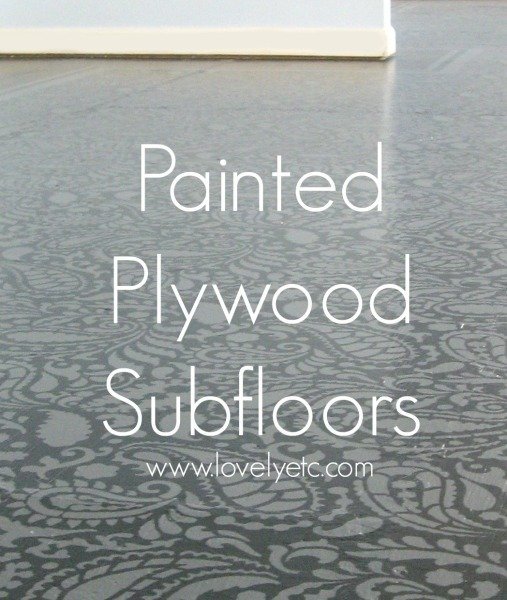
This post contains affiliate links which means if you make a purchase after clicking a link I will earn a small commission but it won’t cost you a penny more. Click here to see my full disclosure policy.
Supplies needed to Paint Plywood Subfloors
- Utility knife, hammer, pry bar – for removing old carpet
- Needle-nose pliers, flat head screwdriver, heavy-duty staple remover – for removing the millions of staples left after removing old carpet. You don’t absolutely have to have a staple remover but it makes the job much faster and easier.
- Sander
- Zinsser oil-based primer
- Porch and Floor Paint – I used Valspar Porch and Floor Paint in the colors ‘Chimney Smoke’ and ‘Crucible’.
- Paint roller and tray – a regular 9 inch roller works best for applying primer and the base layer of paint
- painter’s tape
- Stencil – A stencil is optional but does look really beautiful. I used this Allover Paisley Stencil. I also have a list of other great floor stencils here.
- Small foam paint roller (to use with the stencil)
- Rust-Oleum Varathane Crystal Clear Water-Based Floor Finish in Satin
- Varathane floor finish applicator – this makes applying the floor finish so much easier, but you could also use a regular paint roller if you prefer.
How to Paint a Plywood Subfloor
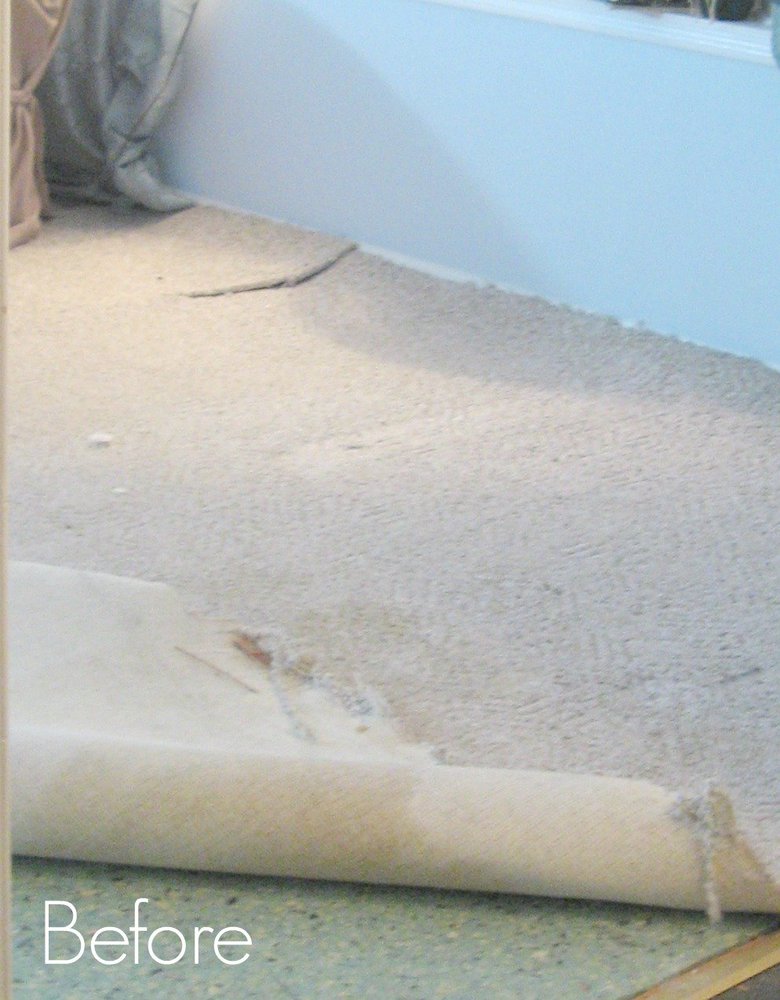
Remove your old flooring
First step, rip out your old carpet and carpet padding. Remove all of the tack strips using a hammer and pry bar.
There will probably also be hundreds of staples left in the subfloor from the carpet padding.
You can remove these by prying them up with a flat head screwdriver and then pulling them out with needle-nose pliers. Or you can use a heavy-duty staple remover. Either way will get the job done but the staple remover makes the job much easier and will save you tons of time.
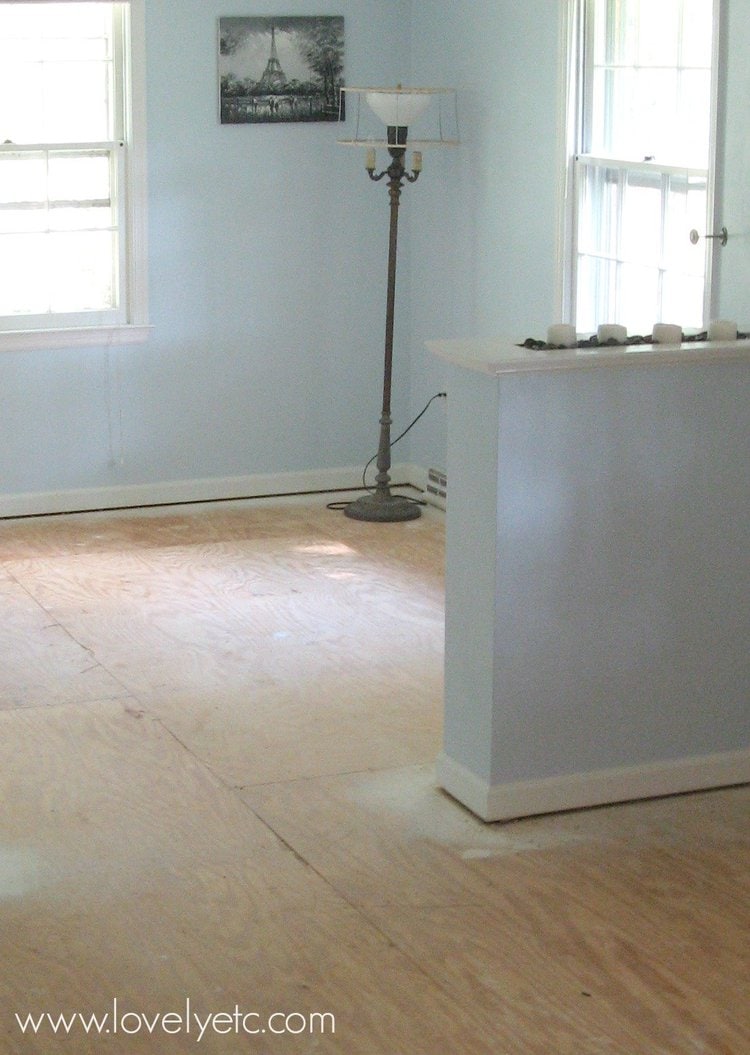
Prepare the subfloor for paint
Once the carpet and staples are gone, it’s time to fill in the seams and staple holes.
This is the only part of my own floors that I really wasn’t pleased with. I used Flexible Floor Patch and Leveler to fill in the seams between boards.
This was not the right choice. It is good because it flexes with the floor and all that stuff. But it is horrible because you can’t sand it smooth.
If I were painting my floors today, I would use DAP Presto Patch Filler. When I was preparing our kitchen subfloors to lay new flooring, I used this to patch several dents and it was great.
It went on easily and I was able to sand it perfectly smooth. This is what I would recommend for preparing your subfloors for paint.
After filling the holes and seams, you are ready to sand the floor. We just used a small orbital sander but of course, a large floor sander would work much faster.
Just remember that this is plywood – it is not going to be silky smooth. The point of sanding is to smooth out major rough spots and smooth any wood filler you used.
Prime the floor
Before painting, you need to prime the floor with a quality primer. The quickest way to do this is to cut in around the edges of the room using a paintbrush and then use a roller with an extension handle to fill in the rest of the floor.
(Quick tip: if you don’t have an extension handle, most broom handles can do the exact same thing.
Just unscrew the handle from your broom and screw it into the handle of your paint roller.)
I used Zinsser Oil-based Primer. This is my favorite primer because it sticks to anything and is very durable.
Just beware, this is an oil-based product so you definitely want to make sure your space is well-ventilated because the fumes can be strong.
You will also need to clean your paintbrush and other supplies using mineral spirits when you are finished.
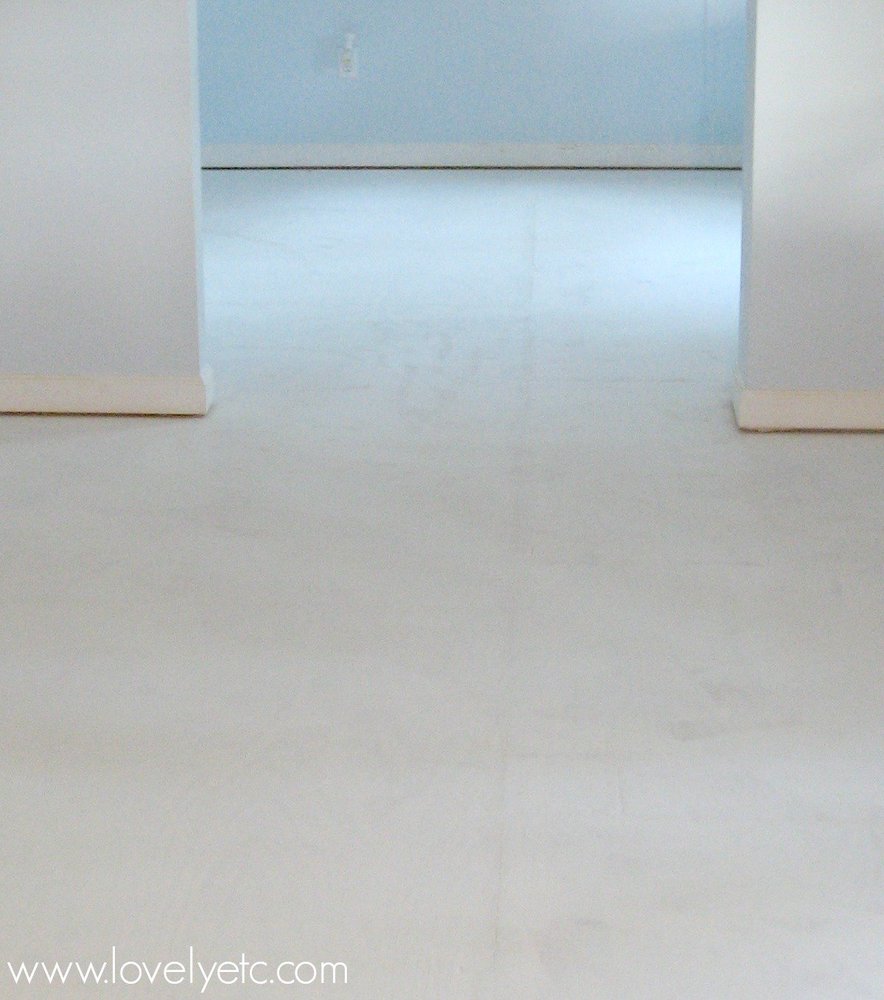
Paint your subfloor
And finally, it is time to paint the subfloor!
First, paint your base color onto the floor. I used Valspar latex porch and floor paint in ‘Chimney Smoke’.
(In case you are wondering latex paint works just fine over oil-based primer; you can’t do oil-based paint over the water-based primer.
I chose to use latex paint instead of oil because it is easier to work with and easier to clean.)
You will probably need to paint a couple of coats to get good coverage.
Painting a border
I chose to paint a double border around the edges of my room and I am so glad I did.
The border really makes the paint job look classy and it also made stenciling the floor much easier because I didn’t have to go all the way to the wall.
To paint the border, use painter’s tape to tape off the area you want to paint.
Seal the edges of the tape by painting over them with your base color. (Yes, first you paint over the tape using the paint color you already painted the floor. This will seal the edges of the painter’s tape so that none of the second color leaks under the tape. This is the secret to getting perfect lines when you use painter’s tape.)
Once that is dry, paint the border using your second paint color. I used Valspar latex porch and floor paint in the color “Crucible”.
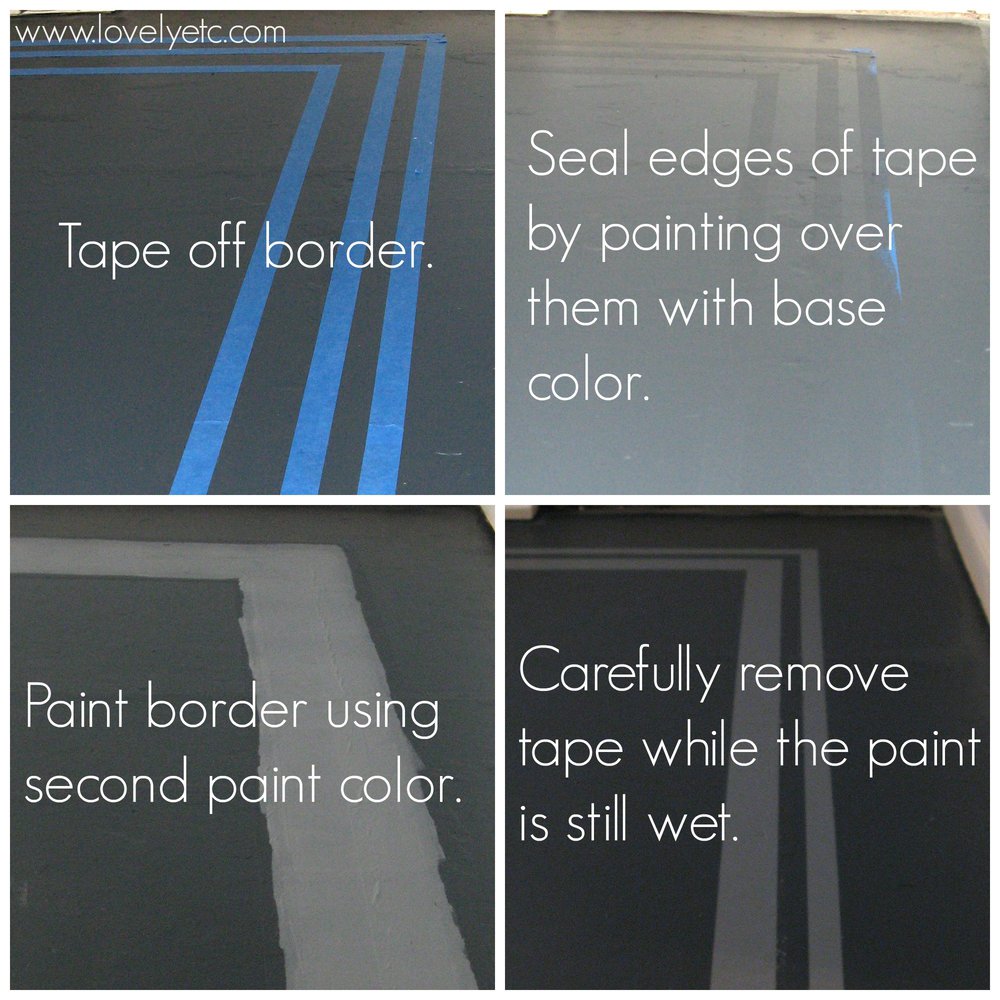
Finally, carefully remove the tape before the paint fully dries. (Removing the tape before the paint dries will keep the fresh paint from peeling.)
Stencil the floor
Time to stencil! Stenciling your floor is obviously optional; paint alone can make a huge difference.
But stenciling really looks beautiful and while stenciling a floor looks intimidating and incredibly time-consuming, it actually goes pretty quickly.
I used this gorgeous Paisley Allover Stencil from Cutting Edge Stencils, but if you are looking for other stencils that are perfect for floors, I shared a bunch of my favorite floor stencils here.
If you paint a border like I did, you only need to stencil inside the border. Place your stencil in one of the corners of the room and use a few pieces of painters tape to hold it in place.
Load a small amount of paint onto a small foam roller and roll it over the stencil.
You want to be careful not to put too much paint on the roller at a time – too much paint can cause your stenciling to look messy.
You should be able to paint the stencil with one thin coat of paint. It might take a couple of tries to figure out the perfect amount of paint to use each time, but then it will go very quickly.
Want more tips for perfecting your stencil technique? I’ve got lots of tips for choosing floor stencils and stenciling floors here.
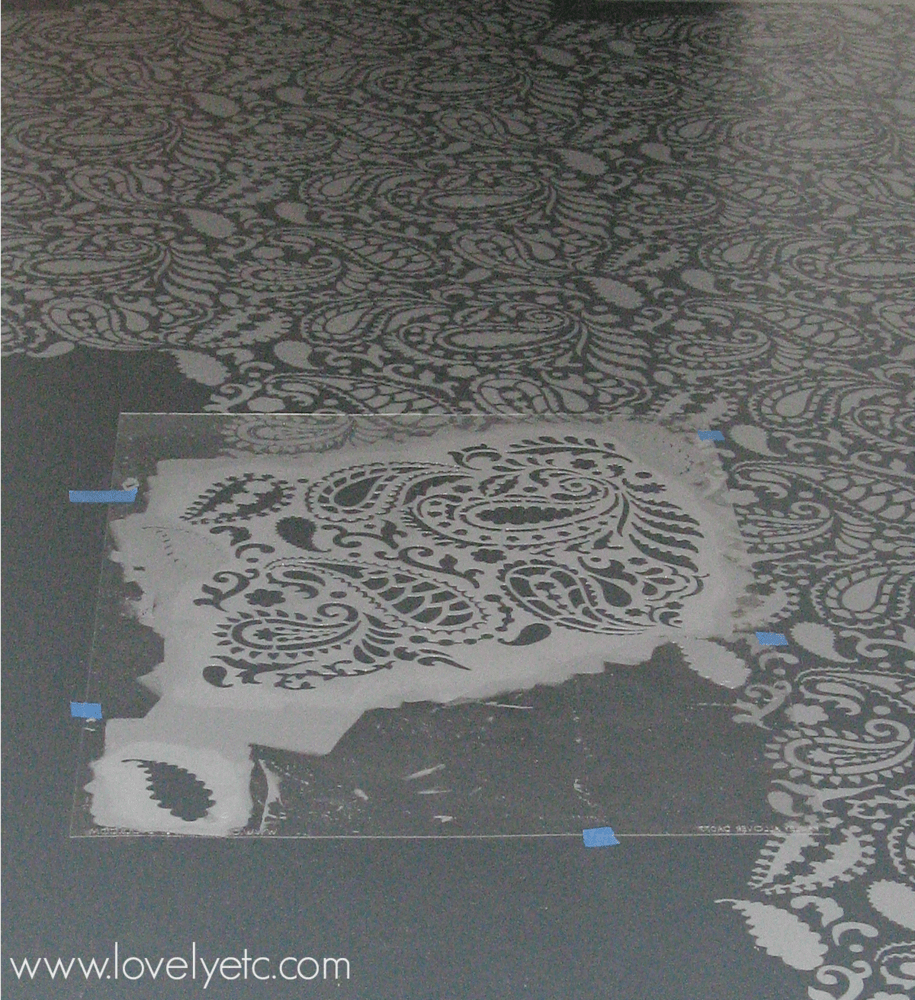
Seal the floor
The final step is sealing the floors. Technically you don’t need to use a sealer over porch and floor paint, but I highly recommend it.
Sealing your floor makes it super durable and also gives it that beautiful, soft shine you expect from a nice floor.
Once the paint is fully dry, carefully remove any dust from the floor surface before sealing. (A microfiber cloth is great for this.) Then carefully apply your floor sealer.
I used Rust-Oleum Varathane Crystal Clear Water-Based Floor Finish in Satin and would highly recommend it.
I applied it using a Varathane floor finish applicator to get a really smooth finish.
I applied four coats of the sealer to make sure the floor was well protected, waiting the recommended amount of time between coats.
After the final coat, I waited an additional four days before moving my furniture back into the room.
That was probably longer than necessary, but I wanted to be extra sure everything was protected!
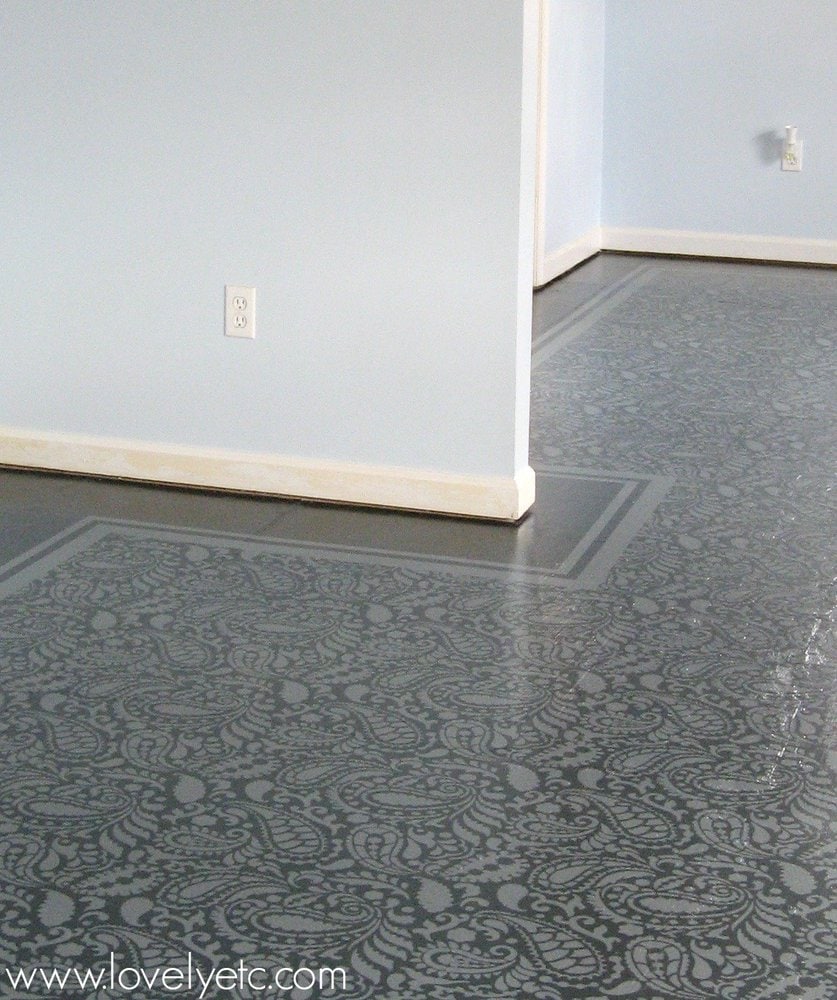
Cost and Time Involved
I painted the floors in my living and dining rooms which combined are around 400 square feet.
This process took me many weeks – mostly because it was around the holidays so I had a lot of other things going on and took lots of breaks.
I would say you would need at least a two-week window though, mostly because of the drying times for the various layers.
My total cost was between $300 and $400. (I already had some materials on hand so it really depends on if you count those.)
This total cost includes the filler, tape, sandpaper, primer, paint, and sealer.
So in the end these floors cost less than $1 per square foot start to finish.
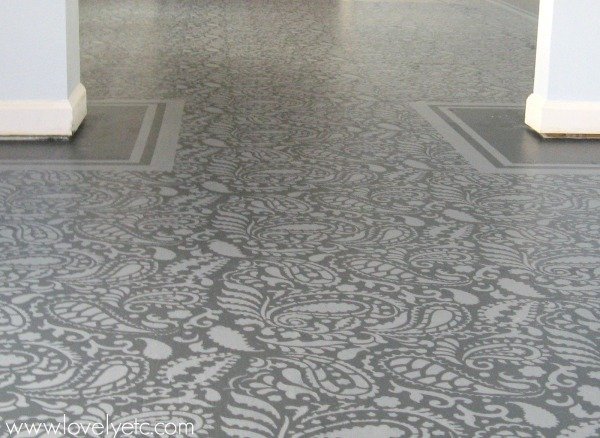
Now that is a beautiful floor! And not only because it was so inexpensive!
Thinking about painting some floors of your own? Or just wondering if a painted floor can really last? I have lots more tips and updates than can help:
- Painted Plywood Floors Update: The Good, The Bad, and The Ugly
- The Absolute Best Floor Stencils and Tips for a Perfectly Stenciled Floor
- Painted Plywood Subfloor: Three Years Later, The Final Update
- 15 Gorgeous Painted Floors: Ideas for Every Type of Flooring
- How to Paint the Most Beautiful Porch Floor Ever
I’d love for you to share this project on Pinterest!
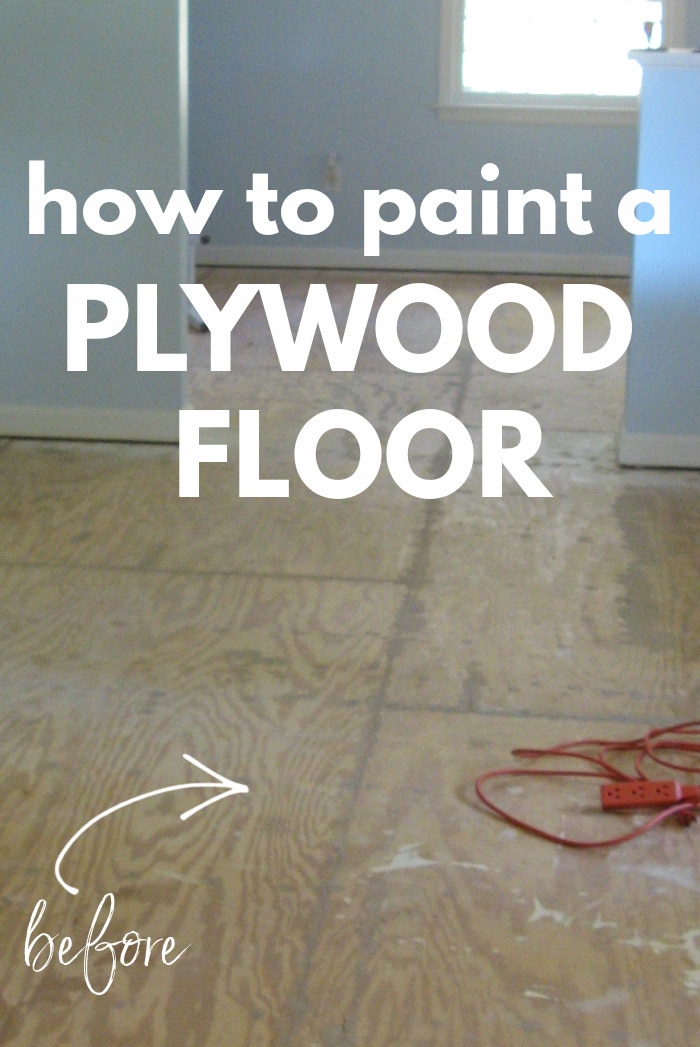
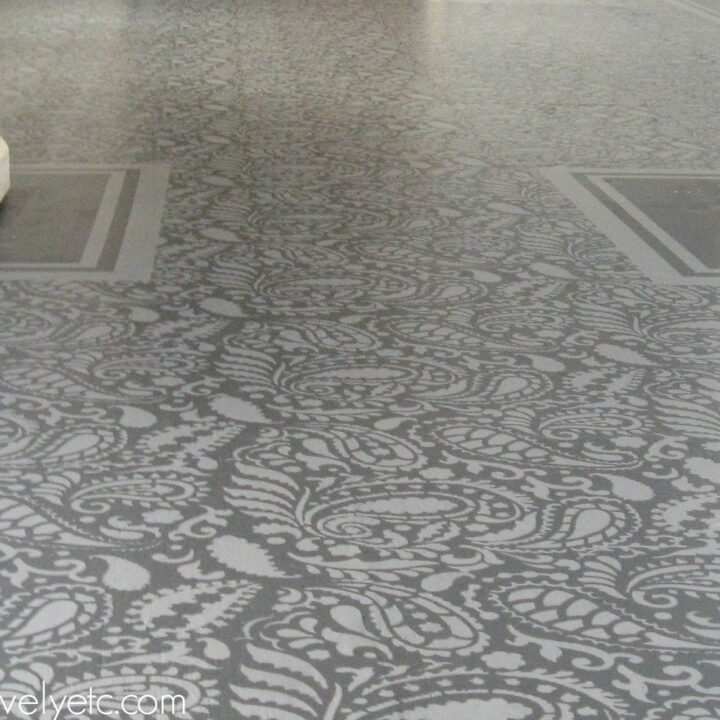
How to Paint a Plywood Subfloor
Create a beautiful painted plywood subfloor or other painted floor with this step-by-step tutorial.
Materials
- DAP Presto Patch Filler
- Zinsser oil-based primer
- Porch and Floor Paint (Valspar Porch and Floor Paint in ‘Chimney Smoke’ and ‘Crucible’)
- Painter’s tape
- Stencil (optional)
- Rust-Oleum Varathane Crystal Clear Water-Based Floor FInish in Satin
Tools
- Sander
- Hammer
- Pry bar
- Needle-nose pliers
- Flat head screwdriver
- Paint roller and tray
- Small foam paint roller (if stenciling)
- Floor finish applicator
Instructions
- Rip out your old carpet and padding.
- Remove all the tack strips using a hammer and pry bar.
- Remove any staples with a flat head screwdriver and pair of needle-nose pliers.
- Patch the seams and staple holes.
- Sand the floor with a small palm sander or a larger belt sander if desired.
- Prime the floor with a quality primer.
- Paint the floors with the base color first. (If you aren't adding a border or stenciling, you can skip to step 15.)
- Use painter’s tape to tape off the border area.
- Paint over the border with the base color.
- Once dry, paint the border using your second paint color.
- Remove the tape before the paint fully dries.
- Place your stencil in one of the corners of the room with a few pieces of painters tape.
- Load a small amount of paint on the foam roller and roll it over the stencil.
- Move the stencil to the next section and repeat until complete.
- Once the paint is dry, seal the floors with several coats of sealer.
- Allow the sealer to fully dry before moving furniture into the room.
Recommended Products
As an Amazon Associate and member of other affiliate programs, I earn from qualifying purchases.
-
 Paisley Allover Wall Stencil – Wall Painting Stencils for Easy Room Makeover – Large Stencil for Painting Walls – Stenciling Instead of Wallpaper Stencils for Walls
Paisley Allover Wall Stencil – Wall Painting Stencils for Easy Room Makeover – Large Stencil for Painting Walls – Stenciling Instead of Wallpaper Stencils for Walls -
 Clare 5 Piece Interior Paint Kit | Includes 2” Paint Brush, 9” Roller Frame, 9” Roller Cover, 11” Metal Tray, and a 11” Tray Liner
Clare 5 Piece Interior Paint Kit | Includes 2” Paint Brush, 9” Roller Frame, 9” Roller Cover, 11” Metal Tray, and a 11” Tray Liner -
 Rust-Oleum 3554 Zinsser High Hide Cover Stain Primer and Sealer, White
Rust-Oleum 3554 Zinsser High Hide Cover Stain Primer and Sealer, White


Love, love, LOVE these floors! I’m getting ready to pull up old linoleum that was under carpet in a den. There’s hardwood underneath, but I’m not sure what shape it’s in. I may just have to follow your lead! I’m definitely going to follow your blog. :)
-Revi
Amazing!! These floors are beautiful. xo, Sherry
This is just insane and genius at the same time!! Wow, what an amazing job!I’m looking form something special to do for our basement remodel and might have to try this out :)
Saw your feature on Whisperwood Cottage! The floors are beautiful and way more interesting and unique than hardwood floors. We pulled out the carpet and painted our concrete subfloor which turned out well but the stencil idea is genius. Your patience and idea certainly paid off in a big beautiful way!
soooo pretty – love the colors and design you chose! can’t imagine how much work this was for you! xo
http://www.northerncottage.net
What a beautiful beautiful job you did! It’s seriously amazing!!! I love it.
I just love what you did. I am saving my money in hopes to tear up my nasty carpet and do this to my floors. Problem is, my floors are a concrete slab, that had at one time, Terrazzo all over floors. But and this is the kicker….. previous owners put junk linoleum tiles over it and that awful, black glue/cement stuff. UGH. I already tore up the carpet in my office and hallway…. huge mess. I popped up the paint splattered tiles and now what the heck to do with that black cement? So very scared to take up the carpet in my bedroom and living room now…. it is a mess. HELP?
Also, I was curious as to what you were going to use to finish your baseboards? All new or add quarter round?
I just became your follower. I myself have done so many house renovations. The work and man hours put into this floor must have been a true labour of love. You got my vote as soon as I saw the first picture.
Besides, I am very FOND of that swirvey curvey design.
WOW This turned out so beautiful
Looks professionally done
Great job Thanks for the inspiration!!!!
xxoo
Pam
This is MEGA INSPIRING!!!!!! Holy cow. I’ve painted floors before, but never thought to use such an intricate pattern. I am in love.
TFS!!
I’m your newest follower :)
So amazing! I just shared a link on my Facebook page :)
Worth every bit of the effort, stunning and so clever! Visiting from Urban Cottage!
Cathy @ Room Rx
Wow…very beautiful. Not sure if I have the patience (or the back) for this kind of project, but I can see why you are happy with the results. Steve from an Urban Cottage sent me over.
I got here from An Urban Cottage too. My teenage daughter was asking me why we couldn’t do this to our sub floors just last week. My fear was the seams and nails. Yours is so lovely I would be happy with just a black painted floor.
Did you ever discover what the right product is for those seams?
Steve from An Urban Cottage sent me. I am totally taken with your tenacity and and patience to do such a stunningly beautiful job with your floors. Way to go!
Camille
Are. You. Kidding Me???? Holy wow. Unbelieveable. Gorgeous. Insanely beautiful. Have never seen anything so beautifully done as a painted floor!!!!! I just found you through An Urban Cottage and I am so blown away I am sending this link to all my DIY buddies. Really, I just can’t get over it. I am so in love with this idea. So glad I found you and am now off to follow you. If your other posts are even near this great, I’m going to love your blog!
Steve from Urban Cottage was bragging on these floors of yours, and he was so right! They look fantastic.
Steve from Urban Cottage sent me. What a wonderful floor! I love it.
Steve from Urban Cottage sent me over. I am so happy he did–your floors look fabulous!! I look forward to visiting your blog again.
That floor is amazing!! I love the paisley stenciled pattern. You’ve just inspired me to rip up the nasty carpeting on my stairs. Nice job.
Following Steve’s advice……following you now….great post! k
I “pinned” your floor a few days ago! LOVE it. (I’m thinking of stenciling my kitchen walls in paisley so I found you in a search) and then TODAY I find you again on one of my FAV blogs! So I’m back again at Steve’s instruction! LOL!
and I’m Following you now!
:D – Cindi
Nice.
What a beautiful job! Very creative and functional! My husband is picking his jaw off the floor in admiration. :)
Wonderful work I love it
An Urban Cottage spoke of you and I found you – as your newest follower I shall welcome your visit
Helenxx
Love this floor. Wish I had saw it earlier. I’m replacing mine with laminant.
I would love to do this to my kitchen, but I was wondering if you think that area has too much traffic…or does that really matter. My house is a small 100 year old Bungalow with a cottage feel….so the wear doesn’t bother me that much….as long as it doesn’t just fall apart.
omg that’s just incredible! wow!
I found your blog on Design Sponge! LOVE the floors, I ‘pinned’ them on Pinterest! :)
*New Subscriber* :D
Truly amazing idea, Carrie. No wonder you’ve been featured so many places. Can’t wait to get our own house so we can try something similar. Thanks for sharing your creativity!
This is beautiful. How long did it take you to stencil the floor? Was it hard to do the repeating pattern?
Wow – what great timing!! I have been pondering and pondering what to do about my ugly carpet and my gross plywood sub floor. I have asked everyone at work for advice…and then I see this post! Fabulous!
Erin
Wow! Gorgeous! Do you have any link parties to how to due this type of floor on a cement sub floor?
Wow! I have never seen anything like this. It looks great!
MC
I LOVE THIS FLOOR TUTORIAL!! I AM COMPLETELY IN AWWHHH!! I’M SAVING THIS IDEA!!
so so pretty, was wondering if this could be done on a cement floor. thanks for the inspiration
YAY! YAY! YAY! I’m so excited I stumbled upon this at A2Z today. I am in the middle of this very project at my house for the very same reason – gross carpet out, cheap alternative in!! I’ve been researching this here and there for the past few months and this is by far THE BEST outcome I’ve seen!!! Thanks for the added inspiration to keep me going!
How long did this take you? My BF is HIGHLY allergic to our cat and the carpet has got to go. I would love to do a “transition floor” until we get the laminate budget.
This is gorgeous!
I found you from pinterest. Now a new follower. You are so smart! I am always looking for inexpencive ways to jazz up my home and you have given me great inspiration, Thanks!
Thank you for the idea. I picked up the carpet in my son’s bedroom due to allergies and painted the floor to be able to clean the dust easier. I made the stencil and I had a really hard time keeping it clean. The paint was bleeding under the edges even though I used spray glue on the back of the stencil. The floor board is not perfectly smooth, it is a strip board and I didn’t want it to be perfectly smooth to prevent slipping. That might have been the problem.
This is so beautiful! Great job! I have a question for you. The sealer that you used is water-based and says not to use it on floors. How have you found it to hold up? Has it been a while since you did this floor? I’m just trying to figure out whether or not I could just get away with using the porch and floor paint and not sealing it…. not sure, though! Help!
Hmm – the sealer is water-based but is made for floors. It says so on the label. And it has held up really well – I am going to give an update in the next week or so. I wouldn’t recommend painting the floor and not sealing it. I did that with porch and floor paint on my screened porch and without the sealer, the floor gets dingy/dirty looking really quickly.
Thank you for the inspiration! We just tore out the carpet in our dining area, stairway and bedrooms. We just bought this home last December and the carpets were nasty! I just couldn’t take it anymore! My intention was the paint the sub-floor until we could afford the barn-board flooring we really want. Many websites try to deter us from painting, saying it will look worse than dingy carpets (not likely!). Your floor is absolutely gorgeous, and was happy to see your comment that the floors held up well! Thanks again for sharing!!
me and my husband painted our floors a couple of months ago…i was shocked how well it looks and lasts. we used some stuff to level the floor out- and you’re right- big mistake. it still looks great and i’m planning to do another area of the house. we used black in an interior eggshell with a sealer over it, and it has held up super great! yours our a lot more time consuming though- and it paid off. ours took us a few hours and then over night to dry…i get a ton of compliments.
Did you use all oil based paints or just an oil-based primer?
Thanks!
Pat
What an amazing transformation! You absolutely did a great job! Your work is so much like that of a professional! The design choice is so good and the color is perfect as well. Thank you for sharing these steps because several homeowners will learn so much from this. Please keep on sharing!
We were inspired by your lovely floor and are beginning our own project. You mentioned filling the seams with a product you would not recommend. What would the alternative be? I can’t seem to see any seams in any of the flooring pictures I have viewed online, but, apparently, one must leave a small gap between sheets of plywood as they swell and shrink. Any input would be valuable! THANKS!
It takes a huge amount of skill and patience to have done that! I am amazed with your work. You painted it like a professional. An advice I could give is to do research about the materials you want to use and the surface you are using it on. Be prepared so that money and time will not go to waste! Thanks for sharing!
I’m thinking about doing my floors. Have you had any issues with splinters? And are you able to walk bare foot on the floors?